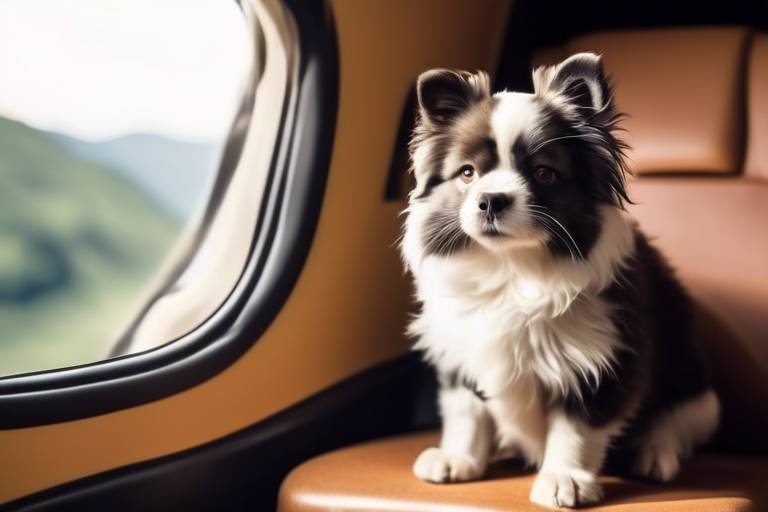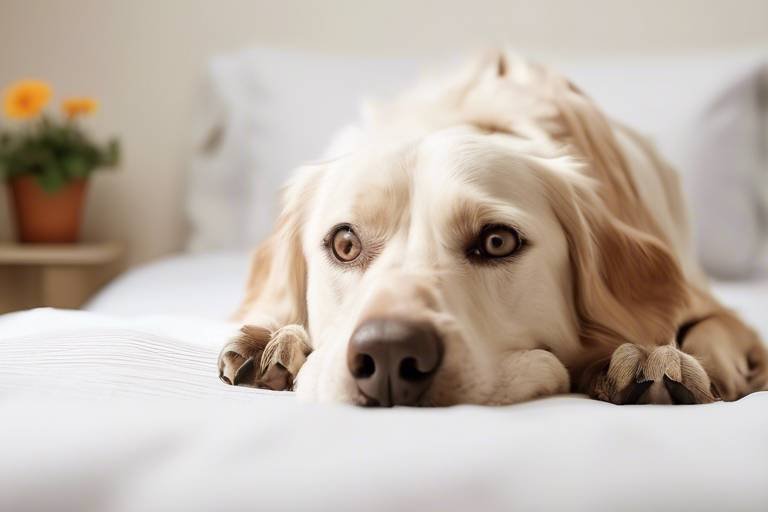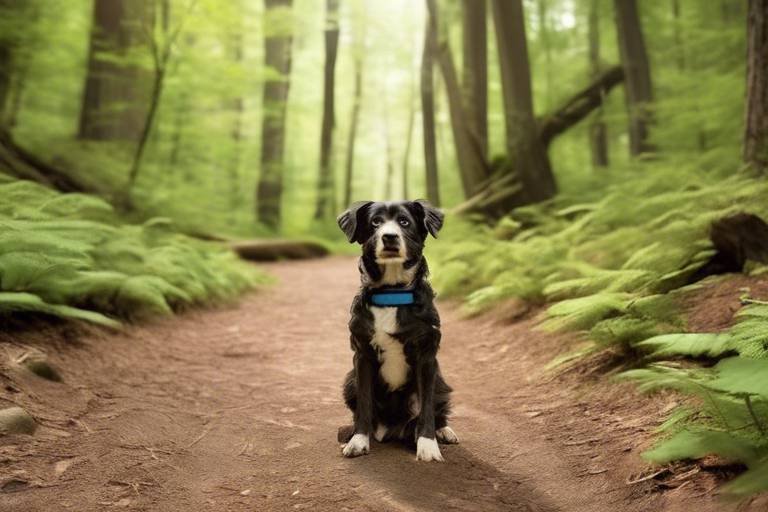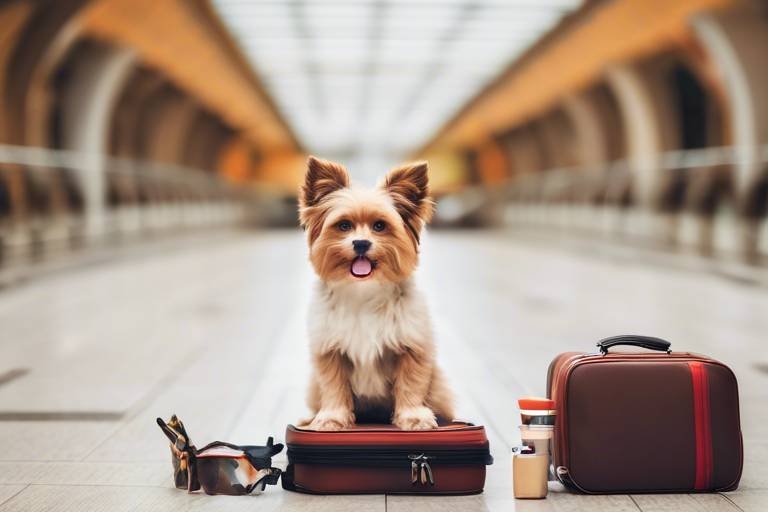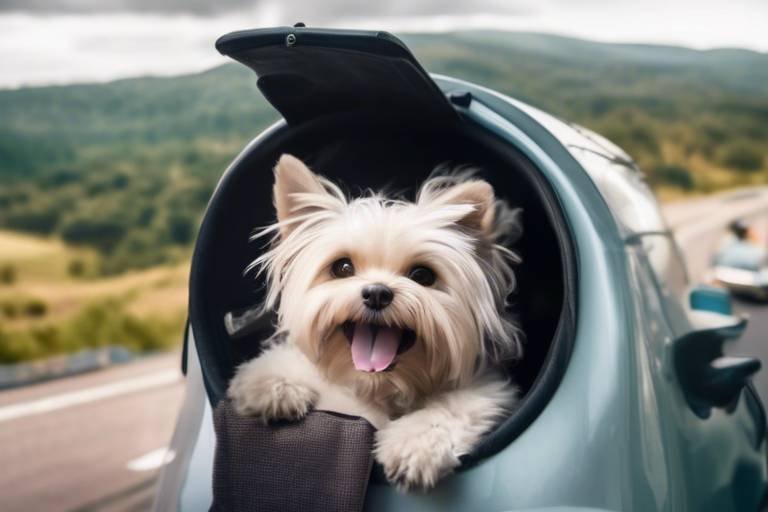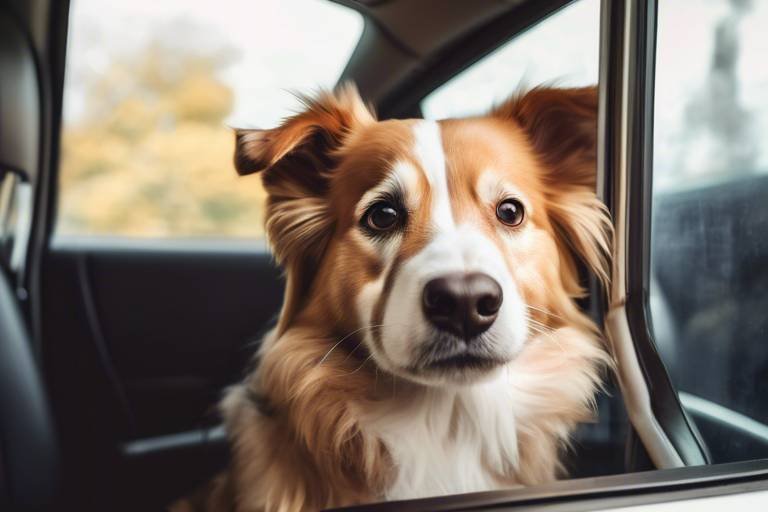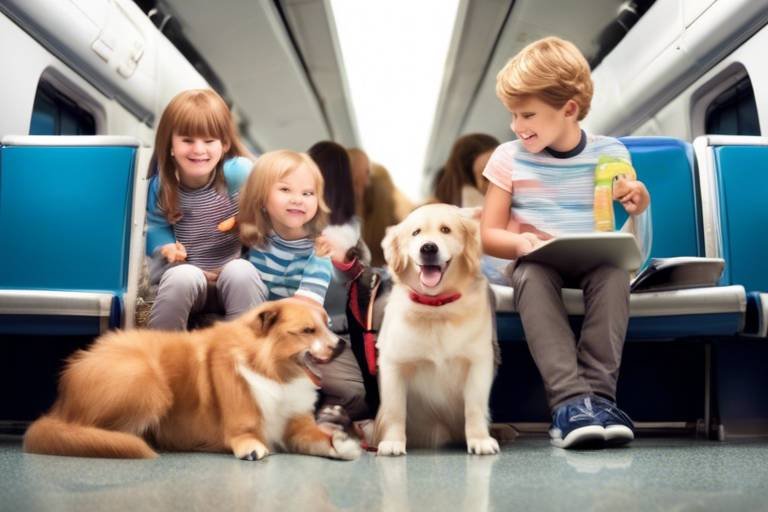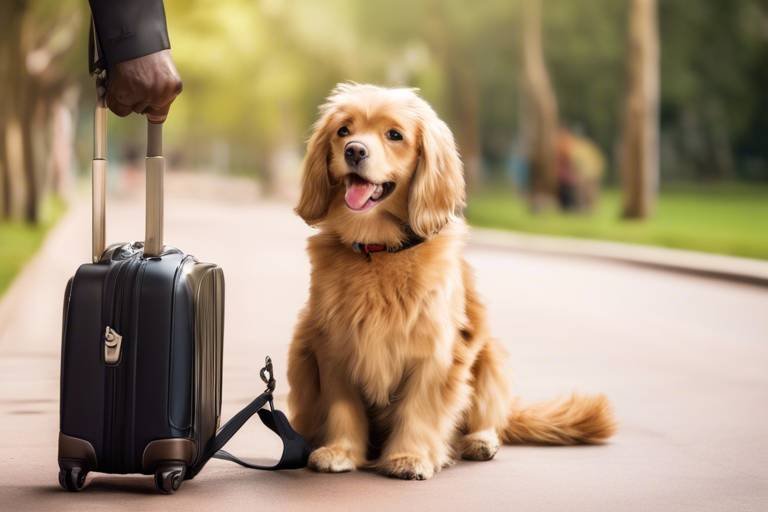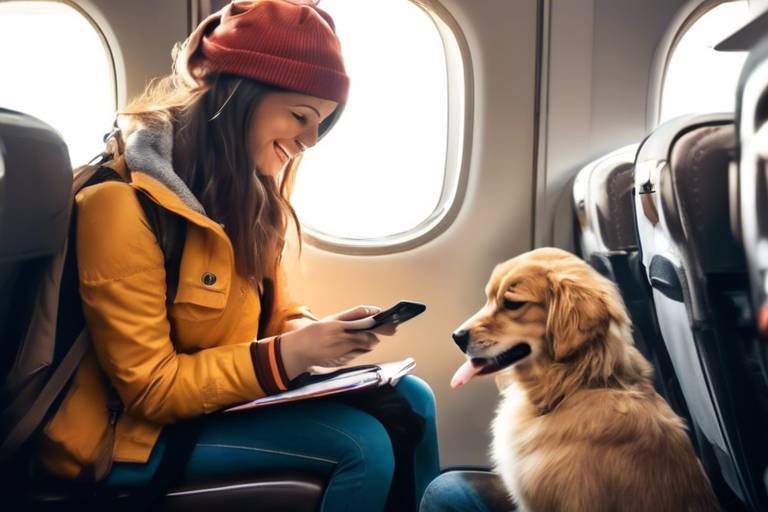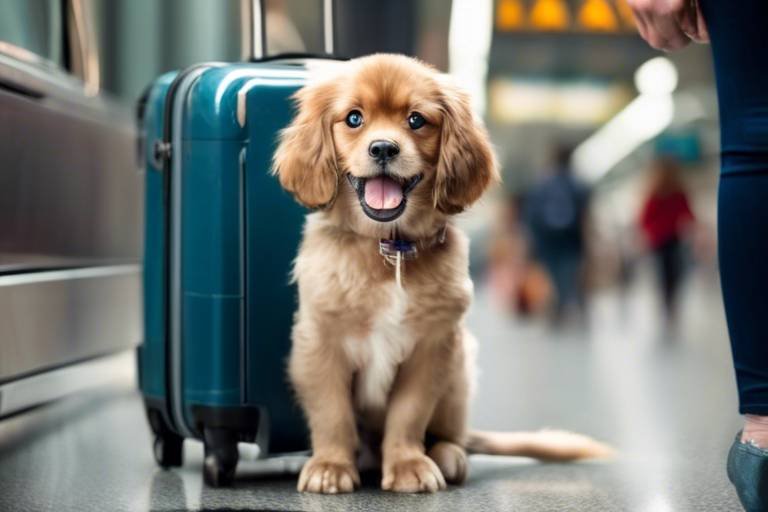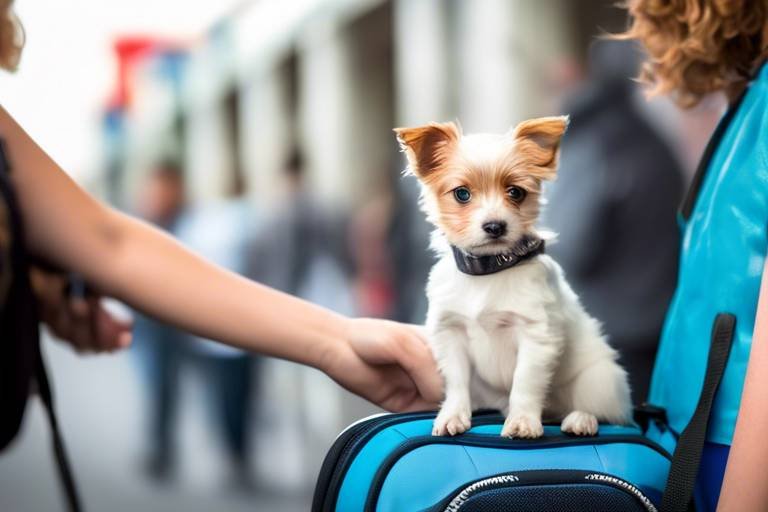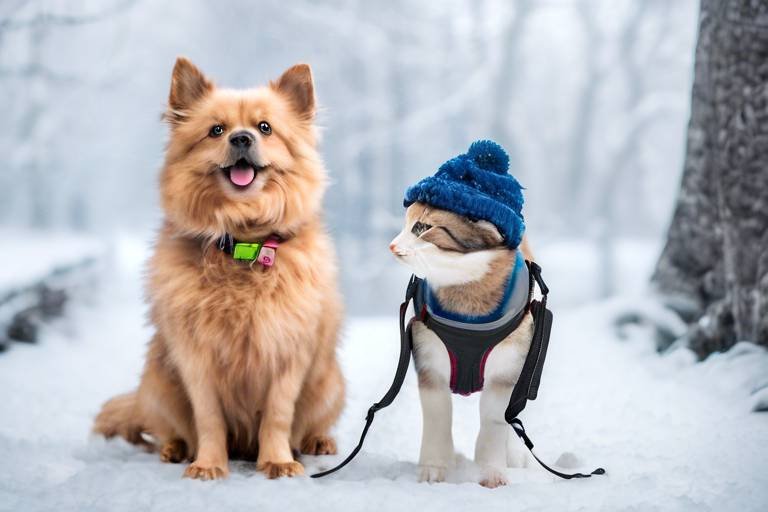How to Create a Comfortable Travel Environment for Your Pet
Traveling with your furry friend can be one of the most rewarding experiences, but it can also come with its own set of challenges. Whether you're planning a quick weekend getaway or a cross-country adventure, creating a comfortable travel environment for your pet is essential. After all, our pets are family, and they deserve to enjoy the journey just as much as we do. So, how do we ensure their comfort and safety while on the road? Let’s dive into some practical tips and strategies that will help make your travels a breeze for both you and your beloved companion.
First things first: selecting the right carrier is crucial for your pet's comfort. You need a carrier that is spacious enough for your pet to move around, yet secure enough to keep them safe during travel. Think of it as their personal little sanctuary on wheels. A well-ventilated carrier is key, allowing fresh air to circulate and preventing your pet from feeling claustrophobic. Look for options with soft sides, as they can provide more comfort than rigid ones. Remember, your pet should feel snug, not trapped!
Before you hit the road, it’s important to prepare your pet for the journey ahead. Just like humans, pets can experience anxiety when faced with new environments. Gradual exposure to the carrier can make a world of difference. Start by letting your pet explore the carrier at home, perhaps even placing their favorite toys or blankets inside. You could also take them on short practice trips around the block. This familiarization process helps reduce anxiety and makes the actual travel smoother. Think of it like a dress rehearsal—getting them ready for the big show!
Before embarking on your adventure, it's wise to ensure your pet is healthy and up-to-date on vaccinations. A quick visit to the vet can help identify any potential issues and provide necessary documentation for travel, especially for longer journeys. You wouldn't want to face unexpected health problems while away from home, right? It's like packing your suitcase and forgetting your favorite shirt—frustrating and easily avoidable!
Keeping your pet hydrated and well-fed during travel is essential. Discuss feeding schedules and water availability with your vet to prevent discomfort or illness on the road. A good rule of thumb is to offer water every couple of hours, especially on hot days. You might also want to consider packing a travel bowl—something lightweight and easy to clean. This way, you can ensure your pet stays refreshed throughout the journey.
When it comes to food, opt for travel-friendly options that are easy to store and serve. Pre-portioning meals can help maintain your pet's routine while minimizing mess during the journey. Think of it as meal prepping for your pet! Just like you wouldn’t want to eat soggy sandwiches on the road, your pet deserves a tasty and nutritious meal, too.
Once you’re on the road, make your vehicle as comfortable as possible for your pet. Use blankets, pillows, and toys to create a familiar environment. This can help ease any anxiety during travel. Imagine how you would feel on a long car ride without your favorite playlist or a cozy blanket—pretty uncomfortable, right? Your pet deserves that same level of comfort. And don’t forget to secure the carrier properly to prevent any sudden movements that might startle your pet.
Many pets experience anxiety during travel, which can lead to a stressful situation for both of you. Understanding your pet's behavior is crucial. Look for signs of stress, such as whining, pacing, or excessive drooling. Using calming techniques can significantly improve their experience. This might include playing soft music, speaking to them in a soothing voice, or even using a favorite toy as a comfort item. Remember, a calm pet makes for a happy journey!
Explore various calming aids, such as pheromone sprays, anxiety wraps, or natural supplements, to help soothe your pet during travel. Each pet may respond differently, so it’s essential to choose what works best for your furry friend. You might want to test these aids during your practice trips to see how your pet reacts before the big journey. It’s all about finding that perfect balance, like mixing the right ingredients for a delicious recipe!
For long trips, planning regular breaks is vital. Allow your pet to stretch, relieve themselves, and explore a bit. This helps prevent restlessness and keeps your pet comfortable throughout the journey. Think of it as a mini-vacation for them during your travels. A quick stop at a park can be a great way to let them burn off some energy and enjoy the outdoors before getting back on the road.
After arriving at your destination, it’s important to help your pet adjust. Monitor their behavior and provide a safe space for them to relax and recover from the travel experience. Just like you would want to unwind after a long journey, your pet needs that time too. Set up a cozy spot with their favorite blanket and toys, and give them a little TLC to help them settle in.
- How can I tell if my pet is anxious during travel? Look for signs such as whining, excessive panting, or trying to escape the carrier.
- What should I pack for my pet during travel? Essentials include food, water, bowls, leashes, waste bags, and any medications.
- Can I give my pet calming supplements? Yes, but consult your vet for the best options and dosages for your pet.

Choosing the Right Carrier
When it comes to traveling with your furry friend, is one of the most important decisions you'll make. Think of the carrier as your pet's home away from home; it needs to be comfortable, secure, and spacious enough for them to move around a bit. Imagine yourself crammed in a tiny space for hours on end—it's not a pleasant thought, right? So, let’s dive into what makes a carrier the perfect choice for your pet.
First off, size matters! You want to ensure that your pet has enough room to stand up, turn around, and lie down comfortably. A carrier that’s too small can lead to anxiety and discomfort, which is the last thing you want during a journey. On the other hand, a carrier that's too large can be a safety hazard, as your pet might slide around during transit, causing stress and potential injury. A good rule of thumb is to measure your pet and choose a carrier that is at least a few inches longer and taller than their measurements.
Next, let’s talk about ventilation. A well-ventilated carrier is crucial for ensuring your pet can breathe easily, especially during long trips. Look for carriers with mesh panels or vents that allow for adequate airflow. This will also help keep your pet cool and comfortable, preventing them from overheating. Remember, just like us, pets can get hot and bothered, especially if they’re in a confined space for an extended period.
Another important factor is the carrier's security features. You want to make sure it has a reliable locking mechanism to prevent any accidental escapes. Imagine stopping for a quick break and your pet bolts out of the carrier—yikes! To avoid such a scenario, look for carriers with sturdy zippers or latches. Some carriers even come with safety straps that can be secured to your car’s seatbelt system, providing an extra layer of protection.
For those of you who love to travel with larger pets, consider investing in a hard-sided carrier. These carriers offer more protection and stability, especially during car rides. However, if your pet is more of a cuddle bug, a soft-sided carrier might be the way to go. They tend to be more flexible, lightweight, and easier to store. Just keep in mind that soft-sided carriers may not provide as much protection in case of an accident.
Lastly, don’t forget to make the carrier inviting! Adding a familiar blanket or a favorite toy can make a world of difference. It’s like packing a little piece of home for your pet, which can help reduce their anxiety during travel. You might also want to consider using a calming spray or a few drops of lavender oil on their blanket to create a soothing atmosphere.
In summary, the right carrier can make or break your pet's travel experience. By considering size, ventilation, security, and comfort, you’ll set your furry friend up for a much more enjoyable journey. So, before you hit the road, take a moment to choose wisely—your pet will thank you!

Preparing Your Pet for Travel
Before you hit the road with your furry friend, it's essential to prepare your pet for travel. Just like us, pets can feel a bit anxious about new experiences, especially when it involves being in a confined space like a carrier or a car. To make the journey as smooth as possible, you should start by gradually introducing your pet to their travel carrier. Think of it as a cozy little den that they can call their own. Leave the carrier open at home with their favorite toys and treats inside, encouraging them to explore it at their own pace. This not only helps them get used to the carrier but also makes it a familiar and safe space.
Next, consider taking your pet on short practice trips. Whether it's just a drive around the block or a visit to a friend’s house, these mini-adventures can help acclimate them to the motion and sounds of traveling. Just like how we might feel nervous before a big trip, pets can also experience pre-travel jitters. These practice runs will help reduce their anxiety and make the actual journey feel less daunting. Remember, patience is key! Don’t rush the process; allow your pet to adjust at their own pace.
Before you embark on your adventure, it’s crucial to ensure that your pet is in good health and up-to-date on vaccinations. A visit to the vet can work wonders. Not only will they check for any underlying health issues, but they'll also provide you with the necessary documentation that may be required for travel, especially if you're crossing state lines or flying. Just like how we need a passport for international travel, your pet might need proof of vaccinations. So, don’t skip this step!
Keeping your pet hydrated and well-fed during travel is essential. Discuss feeding schedules and water availability with your vet to prevent discomfort or illness on the road. Just like we can get cranky when we're hungry or thirsty, pets can become restless and anxious. Make sure to carry enough water and some of their favorite snacks. A well-fed pet is a happy pet!
When it comes to food, opt for travel-friendly options that are easy to store and serve. Consider portioning meals in advance to maintain your pet's routine while minimizing mess during the journey. You wouldn't want to deal with a messy car, right? Pre-packaged meals or resealable containers can make feeding time a breeze, ensuring that your pet stays on schedule and feels comfortable throughout the trip.
In summary, preparing your pet for travel involves creating a familiar environment, ensuring their health, and maintaining their routine. By taking these steps, you'll not only ease their anxiety but also enhance the overall travel experience for both of you. So, pack those treats, grab the favorite toys, and get ready for an adventure that your pet will love!
Q: How can I tell if my pet is anxious about traveling?
A: Signs of anxiety in pets can include excessive barking, whining, pacing, or trying to escape the carrier. Watch for these behaviors and take steps to comfort them.
Q: Should I feed my pet before a long trip?
A: It’s best to feed your pet a few hours before travel to allow for digestion. However, consult your vet for specific recommendations based on your pet's needs.
Q: Is it safe to give my pet calming aids?
A: Many calming aids are available, but it's important to consult your vet before giving any supplements to ensure they are safe for your pet.
Q: How often should I take breaks during a long trip?
A: Plan for breaks every 2-3 hours to allow your pet to stretch, relieve themselves, and hydrate. This will help keep them comfortable and happy!
Health Check and Vaccinations
Before you hit the road with your furry companion, a health check is not just a good idea; it's essential! Just like you wouldn’t want to embark on a journey feeling under the weather, your pet deserves to feel their best too. Scheduling a visit to the vet can help ensure that your pet is healthy and ready for the adventure ahead. During this visit, the vet can perform a thorough examination to identify any potential health issues that might arise during travel.
Moreover, keeping your pet’s vaccinations up-to-date is crucial for their well-being. Many destinations require specific vaccinations, and having the proper documentation can save you from headaches later on. Here’s a quick rundown of some common vaccinations that your pet might need:
| Vaccination | Recommended For | Frequency |
|---|---|---|
| Rabies | Dogs, Cats | Every 1-3 years |
| DHPPC (Distemper, Hepatitis, Parvovirus, Parainfluenza) | Dogs | Every 3 years |
| FVRCP (Feline Viral Rhinotracheitis, Calicivirus, Panleukopenia) | Cats | Every 3 years |
In addition to vaccinations, your vet can also provide you with a health certificate, which might be required if you’re traveling across state lines or internationally. This document proves that your pet is healthy and has received all necessary vaccinations. It’s like a passport for your pet, ensuring that they can travel with you without any hiccups!
Lastly, don’t forget about preventive care! Discuss flea, tick, and heartworm prevention with your vet, as these pesky critters can be more than just a nuisance during travel. Keeping your pet protected means you can focus on making memories instead of dealing with unwanted visitors. So, take the time to ensure your pet is in top shape before your trip; it’s a small step that can lead to a big difference in their travel experience!
- How far in advance should I schedule a vet appointment? It's best to schedule your appointment at least a few weeks before your trip to allow for any necessary vaccinations or treatments.
- What if my pet has a pre-existing condition? Always discuss pre-existing conditions with your vet to ensure your pet is fit for travel and to get specific advice based on their needs.
- Are there any travel restrictions for pets? Yes, some destinations have specific regulations regarding pet travel, including required vaccinations and quarantine periods. Always check the rules for your destination ahead of time.
Hydration and Nutrition
When it comes to traveling with your pet, hydration and nutrition are two of the most critical factors to consider. Just like us, our furry friends need to stay hydrated to maintain their energy levels and overall well-being. Before you hit the road, make sure to pack enough water for your journey. A good rule of thumb is to provide your pet with about 1 ounce of water per pound of body weight per day. This can vary depending on the weather and your pet's activity levels, so always keep an eye on them and adjust accordingly.
It’s also essential to plan your pet's meals around your travel schedule. Feeding them right before a trip can lead to discomfort, especially during long car rides. Instead, consider feeding them a few hours before you leave. This will give their system time to digest and help prevent any car sickness. If you're traveling for an extended period, consult your veterinarian about the best feeding schedule. They might recommend smaller, more frequent meals to keep your pet comfortable.
Don't forget about the type of food you're bringing along! Opt for travel-friendly pet food that is easy to store and serve. Look for options that come in resealable bags or containers to minimize mess. You can even pre-portion meals into individual servings to maintain your pet's routine. This way, you can simply grab a bag and serve it without the hassle of measuring out food on the go. To give you a clearer picture, here’s a quick table to help you plan your pet's hydration and nutrition:
| Pet Size | Water Intake (oz/day) | Recommended Meal Frequency |
|---|---|---|
| Small (up to 20 lbs) | 20 oz | 2-3 meals/day |
| Medium (21-50 lbs) | 30-50 oz | 2 meals/day |
| Large (51+ lbs) | 50+ oz | 2 meals/day |
Finally, always ensure that your pet has access to fresh water during breaks. Stopping every couple of hours not only allows your pet to stretch their legs but also gives them a chance to hydrate. In addition to water, consider bringing along some high-quality treats for those long stretches on the road. These can serve as a great way to reward your pet for good behavior and help keep their spirits high during the journey.
1. How often should I stop for my pet during a long trip?
It's recommended to stop every 2-3 hours to allow your pet to stretch, relieve themselves, and drink water.
2. Can I give my pet ice cubes for hydration?
While some pets enjoy ice cubes, it's best to offer them water instead, especially during travel, to ensure they stay hydrated.
3. What should I do if my pet refuses to eat during travel?
It's not uncommon for pets to lose their appetite while traveling. If your pet refuses to eat, try offering smaller, more frequent meals and ensure they are comfortable. If the issue persists, consult your veterinarian.
4. Is it safe to travel with my pet in the car?
Yes, traveling with your pet can be safe as long as you take the necessary precautions, such as using a secure carrier or harness, ensuring proper hydration and nutrition, and making frequent stops.
Travel-Friendly Pet Food
When it comes to traveling with your beloved pet, one of the most vital aspects to consider is their nutrition. After all, a happy pet is a well-fed pet! Choosing can make all the difference in ensuring your furry friend stays healthy and comfortable during your journey. So, what exactly does "travel-friendly" mean? It refers to food that is easy to store, serve, and manage while on the go.
First and foremost, you want to look for food that comes in compact packaging. This not only saves space in your luggage but also minimizes the chances of spills and messes. Many brands offer specially designed travel packs that are lightweight and resealable, making them perfect for road trips or flights. Additionally, consider opting for dehydrated or freeze-dried meals. These options are not only lightweight but also have a long shelf life, which is a bonus if your travel plans change unexpectedly.
Another important factor is maintaining your pet's regular feeding schedule. To do this, you can pre-portion your pet's meals into individual bags. This way, you can easily grab a bag at mealtime without having to measure out food in a rush. It's like having a mini buffet for your pet while you’re on the road! Just be sure to keep a close eye on the expiration dates and rotate your stock to keep everything fresh.
Don't forget about hydration! Always ensure that you have enough water for your pet, especially during long trips. You can invest in a portable water bottle designed for pets or use collapsible bowls for easy access. Keeping your pet hydrated is just as crucial as feeding them, particularly in hot weather.
In case your trip involves multiple stops, consider bringing along some of your pet's favorite treats. Not only can they serve as a quick snack, but they can also be used as a reward for good behavior during travel. Remember, a little bit of love goes a long way in keeping your pet calm and happy!
To summarize, here are some key points to keep in mind when choosing travel-friendly pet food:
- Look for compact, resealable packaging.
- Consider dehydrated or freeze-dried options for easy storage.
- Pre-portion meals to maintain a regular feeding schedule.
- Always have enough water and portable bowls on hand.
- Include favorite treats for rewards and comfort.
By planning ahead and selecting the right food for your pet, you can help ensure that they remain nourished and content throughout your travels. Just like humans, pets thrive on routine, and a little preparation can go a long way in making their travel experience as enjoyable as yours!
Q: What is the best type of food to bring for my pet while traveling?
A: The best type of food is one that is compact, easy to store, and ideally dehydrated or freeze-dried. This helps maintain freshness and makes it easy to manage on the road.
Q: How can I ensure my pet stays hydrated during travel?
A: Always carry enough water for your pet and consider using a portable water bottle or collapsible bowls for easy access during breaks.
Q: Should I change my pet's diet before traveling?
A: It's best to keep your pet on their regular diet to avoid any digestive issues. If you do want to introduce a new food, do so at least a week before your trip to allow their system to adjust.
Q: How can I keep my pet calm during travel?
A: Bring along their favorite toys or blankets, use calming aids if necessary, and make frequent stops for exercise and bathroom breaks.
Creating a Comfortable Space in the Vehicle
When it comes to traveling with your furry friend, creating a comfortable space in the vehicle is essential for a smooth journey. Just like you wouldn’t want to sit in an uncomfortable seat for hours, your pet deserves a cozy spot to relax while on the road. Start by choosing the right location for your pet's carrier or bed in the vehicle. Ideally, it should be positioned in a secure area where they can see you, but also feel safe and snug. This could be in the back seat or even in the trunk if it's a spacious SUV, as long as they have proper ventilation.
Next, consider using soft blankets and familiar toys to create an inviting atmosphere. Pets are creatures of habit, and having their favorite items can significantly reduce anxiety. It’s like bringing a piece of home along with you! Make sure to use a non-slip blanket or mat to keep their space stable during the ride. This not only provides comfort but also prevents any sliding around that could lead to injuries.
Don’t forget about temperature control! Pets can get hot quickly, especially in a confined space. Ensure that the vehicle is well-ventilated, and if it’s a warm day, consider using sunshades on windows to block out harsh sunlight. A comfortable temperature will keep your pet relaxed and happy, making the journey more enjoyable for both of you.
Moreover, if your pet tends to get car sick, you might want to prepare by not feeding them a heavy meal right before the trip. Instead, opt for a light snack and keep water available in a spill-proof container. This helps prevent any discomfort during the ride. You can also take advantage of pet seatbelts or harnesses designed for safety. These not only keep your pet secure but also prevent them from roaming around the vehicle, which can be a distraction while driving.
Lastly, remember to take frequent breaks during long trips. This allows your pet to stretch their legs, hydrate, and relieve themselves. It’s a win-win situation: your pet gets to enjoy a bit of fresh air, and you get a chance to rest and recharge too. By creating a comfortable environment in your vehicle, you’re setting the stage for a delightful travel experience that you and your pet will cherish.
- What is the best type of carrier for my pet? Look for a carrier that is spacious, well-ventilated, and secure. It should allow your pet to stand, turn around, and lie down comfortably.
- How can I reduce my pet's travel anxiety? Gradually acclimate your pet to the carrier and use calming aids like pheromone sprays or anxiety wraps to help soothe them during the journey.
- How often should I take breaks during long trips? Plan to stop every 2-3 hours to allow your pet to stretch, relieve themselves, and explore a bit.
- What should I do if my pet gets car sick? Avoid heavy meals right before travel, and consult your vet for advice on managing car sickness.

Managing Travel Anxiety
Traveling with pets can be one of the most rewarding experiences, but it often comes with its fair share of challenges, particularly when it comes to managing your furry friend's anxiety. Just like us, pets can feel stressed when faced with new environments, loud noises, and unfamiliar smells. So, how do we ensure that our pets remain calm and comfortable during our travels? The key lies in understanding their behavior and employing effective calming techniques.
First off, it’s essential to recognize the signs of anxiety in your pet. These can include excessive barking, whining, pacing, or even attempts to escape their carrier. By being attentive to these behaviors, you can take proactive steps to ease their discomfort. One effective way to manage travel anxiety is through the use of calming aids. These can range from pheromone sprays that mimic calming scents to anxiety wraps that provide gentle pressure, similar to a hug. Each pet is unique, so it’s crucial to experiment with different options to find what works best for your furry companion.
Another effective strategy is to create a familiar environment for your pet while traveling. Bringing along their favorite blanket or toy can provide a sense of security and comfort. Imagine how you would feel if you were in a new place without your favorite pillow or book; your pet feels the same way! Additionally, you can play calming music or use white noise to drown out any unsettling sounds during the journey.
It’s also important to plan for frequent breaks during long trips. Just like us, pets need to stretch their legs and relieve themselves. Stopping every couple of hours can make a world of difference. During these breaks, allow your pet to explore a bit, sniff around, and take in their surroundings. This not only helps them burn off excess energy but also gives them a chance to relax and reset.
For those particularly anxious pets, consider consulting your veterinarian about natural supplements or medications that can help alleviate stress. Some pets may benefit from herbal remedies, while others might require a prescription for anti-anxiety medication. Always consult with your vet to find the best approach tailored to your pet's specific needs.
In summary, managing travel anxiety in pets involves a combination of understanding their behavior, using calming aids, creating a familiar environment, and ensuring regular breaks. With a little preparation and attention, you can turn a potentially stressful experience into an enjoyable adventure for both you and your pet. Remember, a calm pet makes for a happy traveler!
- What are the signs of travel anxiety in pets? Common signs include excessive barking, whining, pacing, hiding, or attempts to escape.
- Can I use calming aids for my pet? Yes, calming aids like pheromone sprays and anxiety wraps can be very effective. Consult your vet for recommendations.
- How often should I take breaks during a long journey? It's recommended to take breaks every 2-3 hours to allow your pet to stretch, relieve themselves, and explore.
- Should I consult my vet about my pet's anxiety? Absolutely! Your vet can provide tailored advice and may recommend supplements or medications if necessary.
Calming Aids and Techniques
Traveling with your pet can be an exhilarating adventure, but it can also stir up some anxiety for our furry friends. Just like humans, pets can feel overwhelmed by the hustle and bustle of travel. To help ease their nerves, there are several that can make a world of difference. Think of these aids as a comforting hug for your pet, helping them feel safe and secure during the journey.
One popular option is pheromone sprays. These sprays mimic the natural calming pheromones that pets produce, creating a sense of familiarity and comfort. Just a spritz in their carrier or on their bedding can work wonders. Additionally, anxiety wraps, which are snug garments designed to apply gentle pressure to your pet's body, can help reduce their stress levels significantly. It’s like a cozy blanket that travels with them!
Another avenue to explore is natural supplements. Many pet owners have found success with herbal remedies or calming chews that contain ingredients like chamomile or valerian root. However, it’s crucial to consult with your veterinarian before introducing any new supplements to ensure they’re safe and suitable for your pet.
In addition to these aids, creating a calm environment in the car can also help alleviate anxiety. Play soft music or use a white noise machine to drown out the sounds of the road. Familiar toys or blankets can provide comfort as well. Remember, every pet is unique, so it may take some experimentation to find the right combination of techniques that works for your furry companion. Be patient and attentive to their reactions, and soon enough, you’ll discover the perfect recipe for a stress-free travel experience.
- What are pheromone sprays, and how do they work?
Pheromone sprays are synthetic versions of the calming pheromones that pets naturally produce. They help to create a sense of security and comfort in stressful situations. - Are anxiety wraps effective for all pets?
While many pets respond positively to anxiety wraps, not all pets will find them comfortable. It’s important to monitor your pet’s behavior and consult with your vet if you have concerns. - Can I use calming supplements without consulting my vet?
It’s always best to consult with your veterinarian before introducing any new supplements to your pet’s routine to ensure their safety and effectiveness. - How can I tell if my pet is anxious during travel?
Signs of anxiety in pets can include excessive barking, whining, panting, drooling, or attempts to escape their carrier. Being observant will help you address their needs more effectively.
Frequent Breaks and Exercise
When it comes to traveling with your pet, one of the most important things to remember is that they need frequent breaks. Just like us, pets can get restless and uncomfortable during long stretches in the car. Imagine being stuck in a confined space for hours on end without a chance to stretch your legs! That's why planning regular stops can make a world of difference. Not only does it give your furry friend a chance to relieve themselves, but it also allows them to stretch their muscles and shake off any pent-up energy.
So, how often should you take breaks? A good rule of thumb is to stop every 2 to 3 hours for at least 15 to 30 minutes. This gives your pet time to explore their surroundings, sniff out new scents, and just be a dog or cat for a bit. If you're traveling a longer distance, consider mapping out pet-friendly rest stops along your route. Many rest areas now have designated spots for pets, making it easier for both of you to take a breather.
During these breaks, don’t just let your pet run around aimlessly. Engage them in some light exercise! A quick game of fetch or a short walk can do wonders for their mood and energy levels. This is especially important for high-energy breeds that can easily become bored and anxious during long trips. If your pet is more laid-back, a leisurely stroll can still help them feel more comfortable and relaxed.
Here’s a quick idea of what a typical break could look like:
| Activity | Duration |
|---|---|
| Stretching and walking | 10-15 minutes |
| Playtime (fetch or tug-of-war) | 5-10 minutes |
| Hydration break (water and snacks) | 5 minutes |
In addition to physical exercise, these breaks are also a great opportunity to check in on your pet's overall well-being. Are they drinking enough water? Are they showing any signs of stress or discomfort? Keeping an eye on their behavior can help you address any issues before they escalate. Remember, a happy pet makes for a happy travel experience!
Finally, don’t forget to bring along some of your pet’s favorite toys or blankets. Familiar items can provide comfort and help them feel more secure during breaks. After all, your goal is to create a travel environment that feels as safe and enjoyable as possible. By incorporating frequent breaks and exercise into your travel plans, you’re setting the stage for a successful journey together.
- How often should I take breaks during a long trip? It's recommended to stop every 2 to 3 hours for 15 to 30 minutes.
- What activities should I do during breaks? Engage your pet in light exercise like walking or playing fetch.
- How can I tell if my pet is stressed during travel? Watch for signs such as excessive panting, whining, or restlessness.
- Should I bring water and snacks for my pet? Yes, keeping your pet hydrated and fed is essential during travel.

Post-Travel Care
After a long journey, your pet may feel a bit disoriented or overwhelmed. Just like humans, pets can experience travel fatigue, and it’s essential to help them transition smoothly into their new environment. Start by giving them a moment to explore their new surroundings at their own pace. Allowing them to sniff around and get familiar with the space can ease their anxiety and make them feel more at home. Remember, your pet relies on you to feel safe and secure!
It’s also crucial to monitor their behavior closely for the first few hours after arrival. Look for signs of stress or discomfort, such as excessive panting, hiding, or refusal to eat. If you notice any of these symptoms, be patient and give them time to adjust. Create a cozy corner with their favorite blanket or bed, where they can retreat to if they feel overwhelmed. This designated space can serve as their safe haven, allowing them to relax and recharge.
Additionally, ensure that your pet has access to fresh water and their regular food. After a long trip, they might be a little hesitant to eat right away, but it’s essential to keep them hydrated. You can offer small amounts of food to encourage them to eat, but avoid overwhelming them with large portions immediately. Gradually reintroducing their feeding schedule can help prevent stomach upset.
Don’t forget about the importance of routine! Pets thrive on consistency, so try to maintain their usual feeding, walking, and playtime schedules as closely as possible. This familiarity will help them feel more secure in their new environment. If you’ve traveled to a different time zone, it might take a little extra time for your pet to adjust, so be patient and understanding.
Lastly, if your pet shows signs of stress that don’t seem to improve after a few days, consider consulting your veterinarian. They can provide advice tailored to your pet’s specific needs and may recommend calming aids or behavioral techniques to help your furry friend settle in.
- How long does it take for my pet to adjust after travel?
Adjustment periods can vary, but most pets will begin to settle in within a few days. Monitor their behavior and provide a comforting environment. - Should I change my pet's diet after travel?
It's best to stick to their usual diet immediately after travel to avoid stomach issues. You can gradually introduce new foods if needed. - What signs should I look for to know my pet is stressed?
Common signs include excessive barking, hiding, panting, and refusal to eat. If these persist, consult your vet. - Can I use calming aids for my pet after travel?
Yes! Calming aids like pheromone sprays and anxiety wraps can be beneficial. Consult your vet for recommendations that suit your pet.
Frequently Asked Questions
- What is the best type of carrier for my pet during travel?
Choosing the right carrier is crucial! Look for one that is spacious, well-ventilated, and secure. Your pet should be able to stand up, turn around, and lie down comfortably. A carrier that feels like a safe haven can make a world of difference during your travels.
- How can I prepare my pet for travel?
Preparation is key! Start by gradually introducing your pet to the carrier. Short practice trips can help ease anxiety. The more comfortable your pet feels with the carrier, the smoother your journey will be. Think of it as a mini-vacation for them!
- Should I take my pet to the vet before traveling?
Absolutely! A vet visit is essential to ensure your pet is healthy and up-to-date on vaccinations. This not only helps identify any potential health issues but also provides necessary documentation for travel, especially for longer journeys.
- How do I keep my pet hydrated during travel?
Hydration is vital! Discuss feeding schedules and water availability with your vet before you hit the road. Carry a portable water bowl and offer water during breaks to keep your furry friend refreshed and happy.
- What should I feed my pet while traveling?
Opt for travel-friendly pet food that is easy to store and serve. Portioning meals in advance can help maintain your pet's routine while minimizing mess. Think of it as packing their favorite snacks for the journey!
- How can I manage my pet's travel anxiety?
Understanding your pet's behavior is crucial. Use calming aids like pheromone sprays or anxiety wraps, and consider natural supplements. Each pet is different, so find what works best for your furry companion. It's all about creating a calming environment!
- How often should I take breaks during long trips?
Plan for regular breaks every couple of hours. This allows your pet to stretch, relieve themselves, and explore a bit. Think of it as a mini adventure for them, which can help prevent restlessness and keep them comfortable.
- What should I do after arriving at my destination?
Once you arrive, give your pet time to adjust. Monitor their behavior and provide a safe, quiet space for them to relax and recover from the travel experience. It's like giving them their own little sanctuary after the journey!

